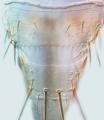Frankliniella invasor
Recognition data
Distinguishing features
Female macropterous; body colour yellow with pale setae, abdominal tergites with faint brown spots laterally joined by grey band behind antecostal ridge; antennal segments VI–VIII brown, also apical half of IV and II; fore wing pale. Antennae 8-segmented, III with pedicel forming a sharp-edged ring, III & IV with forked sensorium, VIII as long as VII. Head wider than long; 3 pairs of ocellar setae present, pair III slightly longer than side of ocellar triangle and arising on anterior margin of triangle; postocular setae pair I present, pair IV as long as distance between hind ocelli. Pronotum with 5 pairs of major setae; anteromarginal setae as long as anteroangulars with four minor setae on anterior margin; one pair of minor setae present medially between posteromarginal submedian setae. Metanotum with 2 pairs of setae at anterior margin, campaniform sensilla present. Fore wing with 2 complete rows of veinal setae. Tergites V–VIII with pair of lateral ctenidia, on VIII anterolateral of spiracle; posteromarginal comb on VIII complete, with short slender microtrichia arising from triangular bases. Sternites III–VII without discal setae.
Related and similar species
Although 230 Frankliniella species are currently listed, most are known only from the neotropics, and no member of the genus is native to Africa or Australia. Two Frankliniella species are widespread around the world, F. schultzei in the tropics and F. occidentalis in more temperate areas. F. invasor has a distinctly sharp-edged ring on the pedicel of antennal segment III, in which character state it ressembles the North American species F. tritici. However, the abdominal tergites have a brown area connecting a pair of lateral grey-brown spots, and apart from this the species is similar to F. kelliae, a common flower-living species in the northern Caribbean. Keys to 74 species recorded from Central America and the Carribean were provided by Mound & Marullo (1996), and to 40 species from Brazil by Cavalleri & Mound (2012).
Taxonomic data
Current valid name
Frankliniella invasor Sakimura
Original name and synonyms
- Frankliniella invasor Sakimura, 1972: 263
Family placement
Thripidae, Thripinae
Biological data
Life history
Breeding in flowers.
Host plants
Recorded from the flowers of a very wide range of unrelated plant species.
Tospoviruses vectored
None
Crop damage
None recorded.
Distribution data
Area of origin
Presumably Central America, although described originally from Hawaii.
Distribution
Hawaii, Costa Rica, Panama, Guatemala, Trinidad, Puerto Rico; potentially invasive to California.




